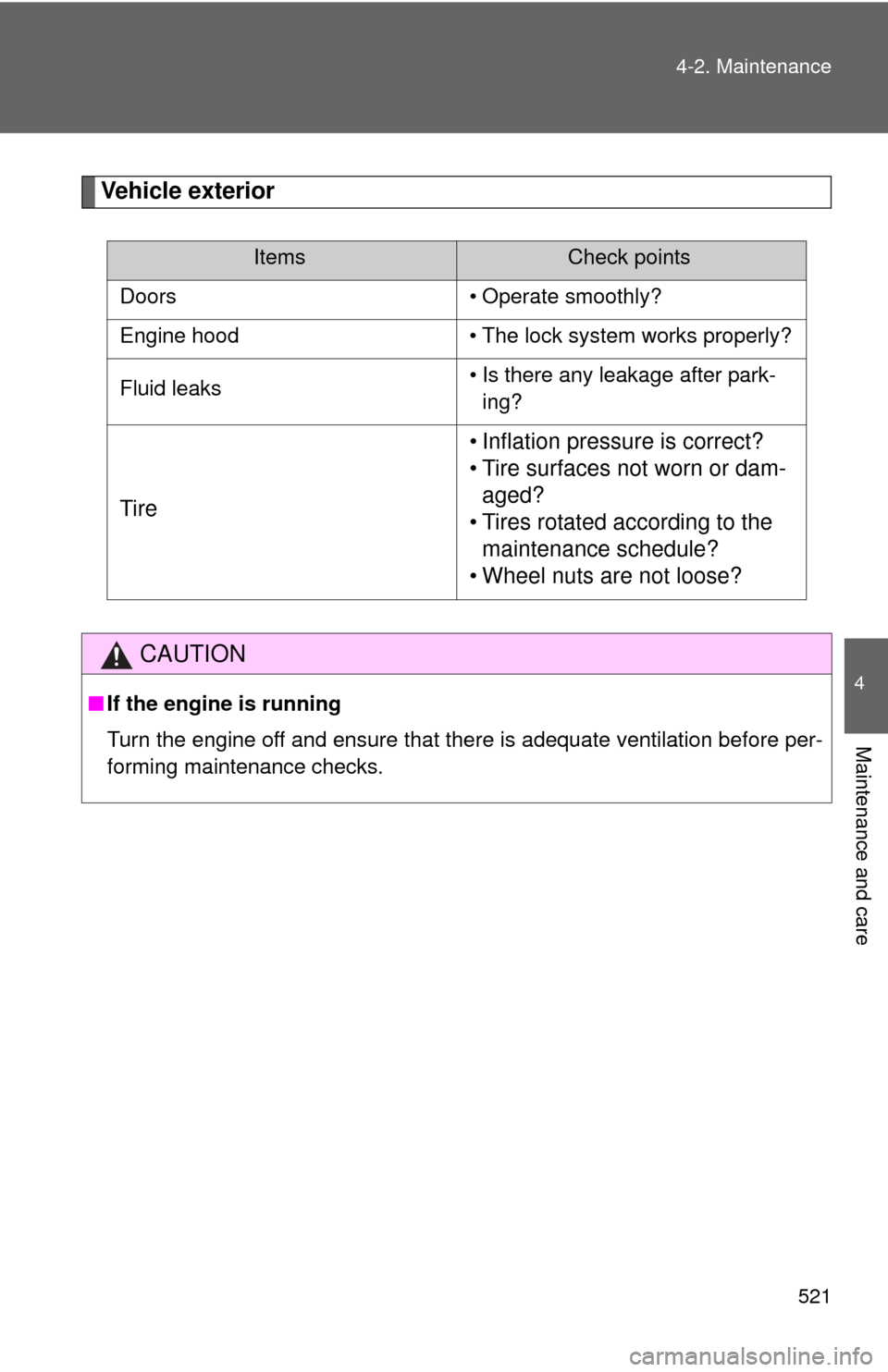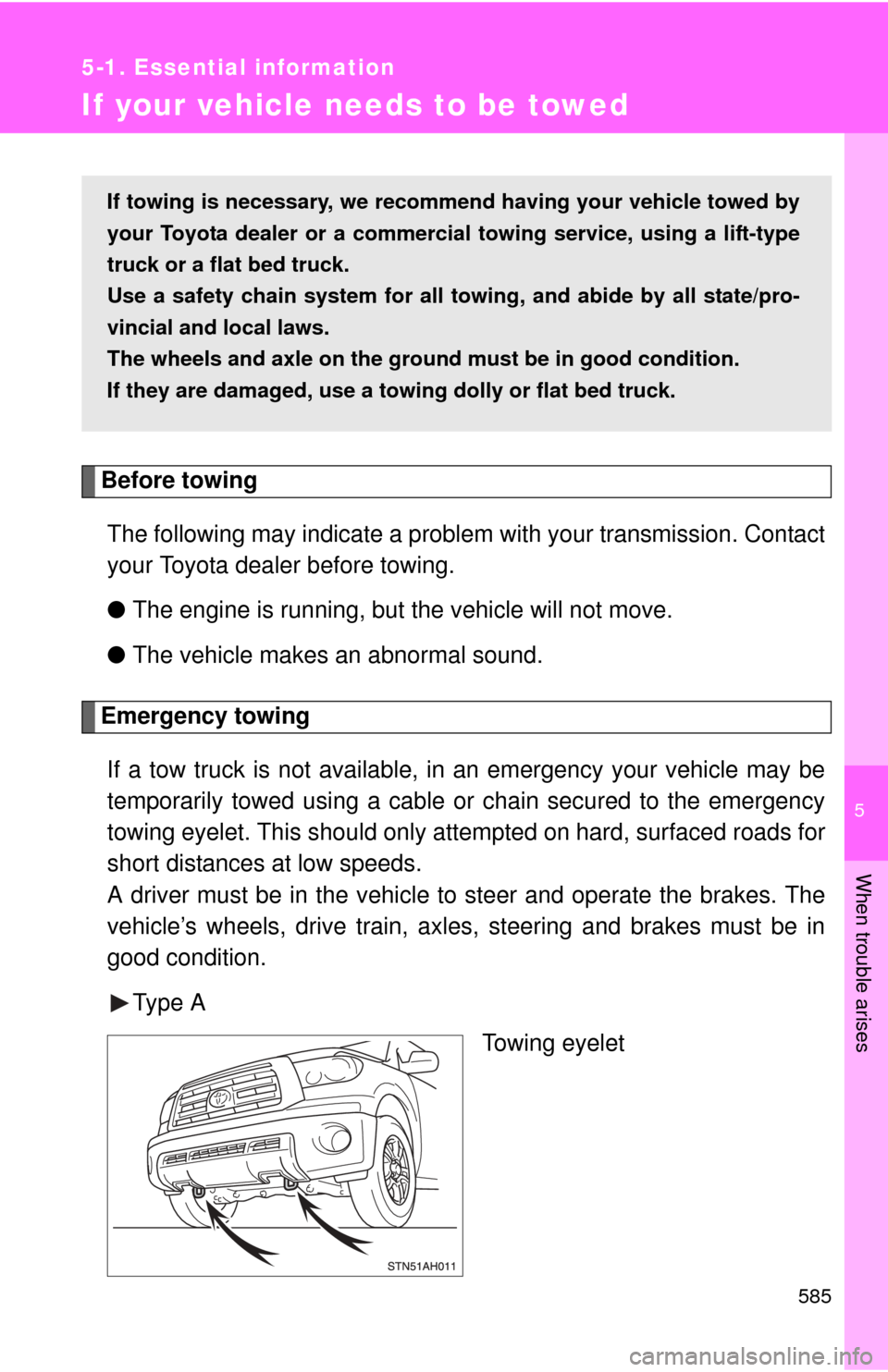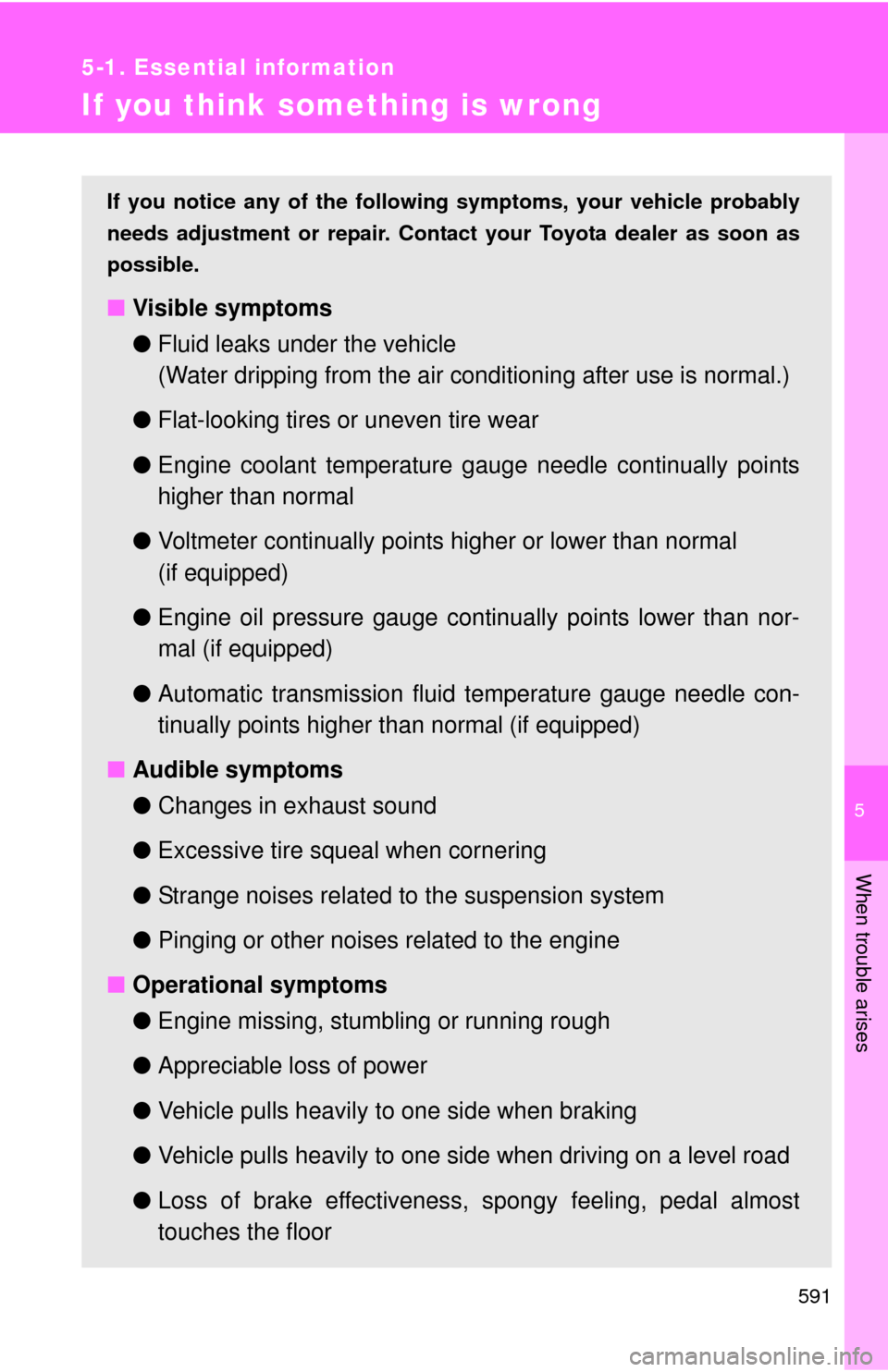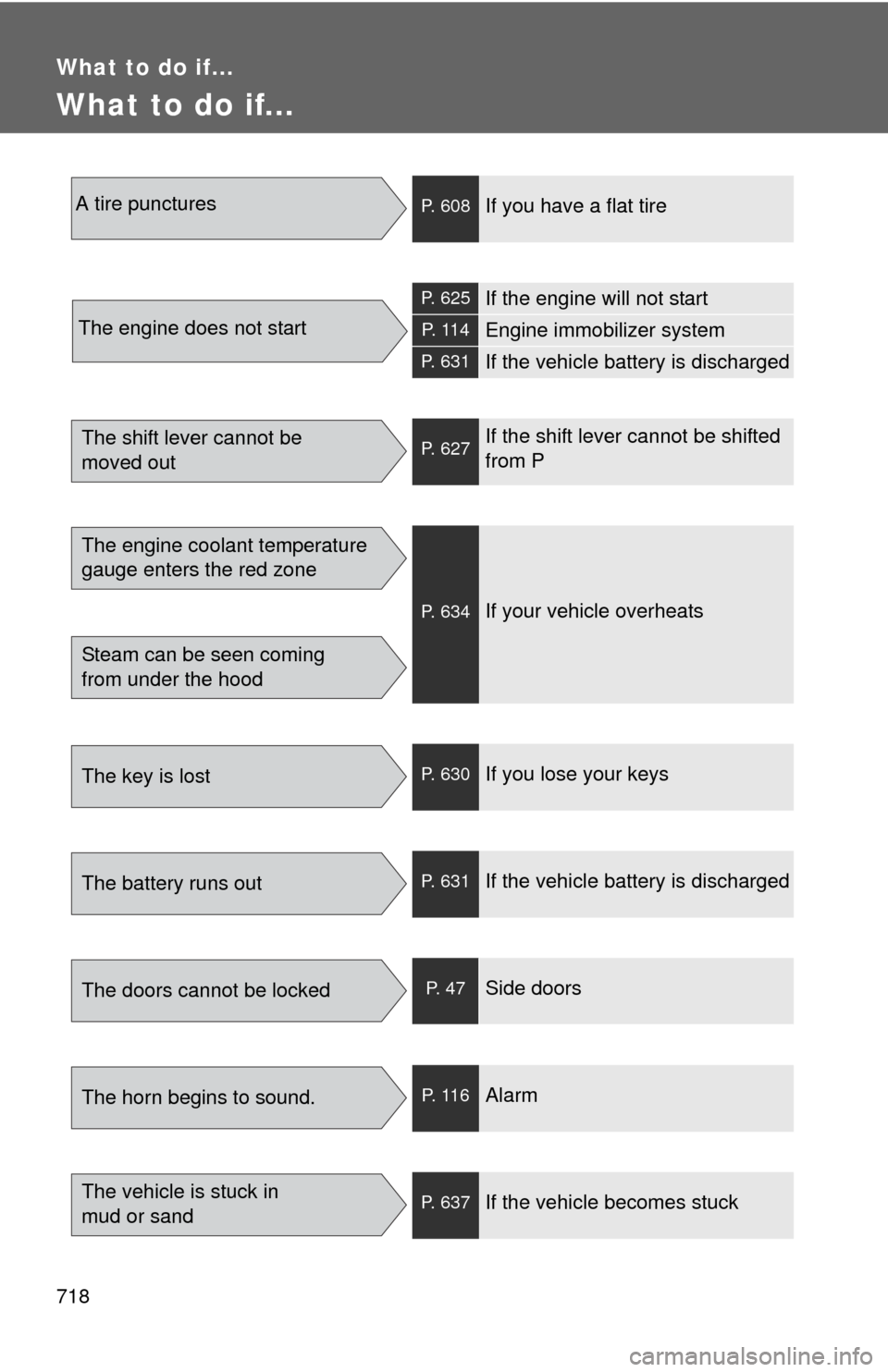2010 TOYOTA TUNDRA run flat
[x] Cancel search: run flatPage 521 of 724

521
4-2. Maintenance
4
Maintenance and care
Vehicle exterior
ItemsCheck points
Doors • Operate smoothly?
Engine hood • The lock system works properly?
Fluid leaks • Is there any leakage after park-
ing?
Tire • Inflation pressure is correct?
• Tire surfaces not worn or dam-
aged?
• Tires rotated according to the maintenance schedule?
• Wheel nuts are not loose?
CAUTION
■ If the engine is running
Turn the engine off and ensure that there is adequate ventilation before per-
forming maintenance checks.
Page 585 of 724

5
When trouble arises
585
5-1. Essential information
If your vehicle needs to be towed
Before towingThe following may indicate a problem with your transmission. Contact
your Toyota dealer before towing.
● The engine is running, but the vehicle will not move.
● The vehicle makes an abnormal sound.
Emergency towing
If a tow truck is not available, in an emergency your vehicle may be
temporarily towed using a cable or chain secured to the emergency
towing eyelet. This should only attempted on hard, surfaced roads for
short distances at low speeds.
A driver must be in the vehicle to steer and operate the brakes. The
vehicle’s wheels, drive train, axles, steering and brakes must be in
good condition.
Type A Towing eyelet
If towing is necessary, we recommend having your vehicle towed by
your Toyota dealer or a commerci al towing service, using a lift-type
truck or a flat bed truck.
Use a safety chain system for all to wing, and abide by all state/pro-
vincial and local laws.
The wheels and axle on the groun d must be in good condition.
If they are damaged, use a towing dolly or flat bed truck.
Page 591 of 724

5
When trouble arises
591
5-1. Essential information
If you think something is wrong
If you notice any of the following symptoms, your vehicle probably
needs adjustment or repair. Contact your Toyota dealer as soon as
possible.
■ Visible symptoms
●Fluid leaks under the vehicle
(Water dripping from the air cond itioning after use is normal.)
● Flat-looking tires or uneven tire wear
● Engine coolant temperature g auge needle continually points
higher than normal
● Voltmeter continually points higher or lower than normal
(if equipped)
● Engine oil pressure gauge continually points lower than nor-
mal (if equipped)
● Automatic transmission fluid temperature gauge needle con-
tinually points higher than normal (if equipped)
■ Audible symptoms
●Changes in exhaust sound
● Excessive tire squeal when cornering
● Strange noises related to the suspension system
● Pinging or other noises related to the engine
■ Operational symptoms
●Engine missing, stumbling or running rough
● Appreciable loss of power
● Vehicle pulls heavily to one side when braking
● Vehicle pulls heavily to one side when driving on a level road
● Loss of brake effectiveness, s pongy feeling, pedal almost
touches the floor
Page 621 of 724

5
When trouble arises
621
5-2. Steps to take in an emergency
CAUTION
■Using the jack
Improper use of the jack may lead to death or serious injuries due to the
vehicle suddenly falling off the jack.
●Do not use the jack for any purpose other than replacing tires or install-
ing and removing tire chains.
●Only use the jack that comes with this vehicle for replacing a flat tire.
Do not use it on other vehicles, an
d do not use other jacks for replac-
ing tires on this vehicle.
●Always check that the jack is securely set to the jack point.
●Do not put any part of your body under the vehicle supported by a jack.
●Do not start or run the engine while your vehicle is supported by the
jack.
●Do not raise the vehicle while someone is in it.
●When raising the vehicle, do not put an object on or under the jack.
●Do not raise the vehicle to a hei ght greater than that required to
replace the tire.
●Use a jack stand if it is necessary to get under the vehicle.
Take particular care when lowering the vehicle to ensure that no one
working on or near the vehicle will be injured.
■Using the jack handle
Insert the square head securely until you hear a click to prevent the
extension parts from coming apart unexpectedly.
■Replacing a flat tire
Observe the following precautions to reduce the risk of death or serious
injury.
●Retighten the wheel nuts within 100 m iles (160 km) of driving. Other-
wise, the nuts may loosen and the wheels may fall off, which could
cause a serious accident.
●Lower the spare tire completely to the ground before removing it from
under the vehicle.
Page 710 of 724

710 Alphabetical index
Compass ................................... 506
Condenser ................................ 535
Console box ............................. 450
Cooling systemEngine overheating ............... 634
CRS ........................................... 143
Cruise control........................... 221
Cup holders .............................. 464
Curtain shield airbags ............. 120
Customizable features..... 206, 684
Daytime running light system .................................... 215
Deck hooks ............................... 498
Defogger Back window ......................... 307
Side mirrors ................... 305, 307
Dimension................................. 640
Dinghy towing .......................... 285
Display Trip information ..................... 204
Warning message ................. 604
Do-it-yourself main tenance..... 523
Doors Door glasses ...........................96
Door lock ...........................44, 48
Open door warning........597, 605
Side doors ...............................47
Side mirrors .............................91
Driver’s seat belt reminder buzzer ............................. 597, 599
Driver’s seat belt reminder light................. 597, 599
Driving
Break-in tips .......................... 175
Correct posture ..................... 118
Driving assist systems........... 243
Procedures ............................ 174
Winter driving tips.................. 260
Driving position memory...........70
DVD player ................................ 386 Emergency flashers................. 584
Emergency flashers switch .... 584
Emergency, in case of
Blown fuse ............................ 560
If the engine will not start ...... 625
If the shift lever cannot be shifted ................................. 627
If the vehicle has
discharged battery .............. 631
If the warning buzzer sounds ................................ 595
If the warning light turns on........................................ 595
If the warning message
is displayed ......................... 604
If you have a flat tire ............. 608
If you lose your keys ............. 630
If you think something is wrong .............................. 591
If your vehicle becomes
stuck ................................... 637
If your vehicle has to be stopped in an emergency ... 638
If your vehicle needs to be towed ............................. 585
If your vehicle overheats ....... 634
Engine Compartment ........................ 528
Engine switch ........................ 183
Exhaust gas .......................... 180
Hood ..................................... 527
How to start the engine ................................. 183
Identification number............. 654
If the engine will not start ...... 625
Ignition switch ...................... 183
Immobilizer system ............... 114
Overheating .......................... 634
Warning light ......................... 596
Engine coolant Capacity ................................ 661
Checking ............................... 534
D
E
Page 718 of 724

718
What to do if...
What to do if...
A tire puncturesP. 608If you have a flat tire
The engine does not start
P. 625If the engine will not start
P. 1 1 4Engine immobilizer system
P. 631If the vehicle battery is discharged
The shift lever cannot be
moved outP. 627If the shift lever cannot be shifted
from P
The engine coolant temperature
gauge enters the red zone
Steam can be seen coming
from under the hood
P. 634If your vehicle overheats
The key is lostP. 630If you lose your keys
The battery runs outP. 631If the vehicle battery is discharged
The doors cannot be lockedP. 4 7Side doors
The horn begins to sound.P. 1 1 6Alarm
The vehicle is stuck in
mud or sandP. 637If the vehicle becomes stuck